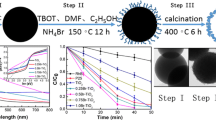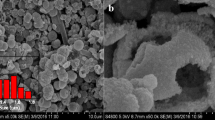Abstract
In this work, we carried out both theoretical calculation and experimental studies to reveal the contribution of hollow geometry to the light utilization efficiency of the TiO2 photocatalysts in diluted aqueous solution. It is found that the single or multi-shelled hollow structures do not induce significant multiple reflections within the shells as widely believed in previous reports, and therefore the geometric factor has minimal contribution to the improvement of the light utilization efficiency of the photocatalyst. To design TiO2 photocatalysts with higher activity, it is more appropriate to focus on the improvement of the crystallinity, diffusion, surface area, and dispersity of the catalysts, rather than their geometric shapes.
Similar content being viewed by others
References
Caruso F, Caruso RA, Moehwald H. Nanoengineering of inorganic and hybrid hollow spheres by colloidal templating. Science, 1998, 282: 1111–1114
Arnal PM, Comotti M, Schüth F. High-temperature-stable catalysts by hollow sphere encapsulation. Angew Chem, 2006, 118: 8404–8407
He Q, Wu Z, Huang C. Hollow magnetic nanoparticles: synthesis and applications in biomedicine. J Nanosci Nanotech, 2012, 12: 2943–2954
Nai J, Tian Y, Guan X, et al. Pearson’s principle inspired generalized strategy for the fabrication of metal hydroxide and oxide nanocages. J Am Chem Soc, 2013, 135: 16082–16091
Sun Y, Wiley B, Li ZY, et al. Synthesis and optical properties of nanorattles and multiple-walled nanoshells/nanotubes made of metal alloys. J Am Chem Soc, 2004, 126: 9399–9406
Fan C, Bian T, Shang L, et al. pH-Responsive reversible self-assembly of gold nanoparticles into nanovesicles. Nanoscale, 2016, 8: 3923–3925
Bian T, Shang L, Yu H, et al. Spontaneous organization of inorganic nanoparticles into nanovesicles triggered by UV light. Adv Mater, 2014, 26: 5613–5618
Koo HJ, Kim YJ, Lee YH, et al. Nano-embossed hollow spherical TiO2 as bifunctionalmaterial for high-efficiency dye-sensitized solar cells. Adv Mater, 2008, 20: 195–199
Zhou C, Zhao Y, Bian T, et al. Bubble template synthesis of Sn2Nb2O7 hollow spheres for enhanced visible-light-driven photocatalytic hydrogen production. Chem Commun, 2013, 49: 9872–9874
Liang HP, Zhang HM, Hu JS, et al. Pt hollow nanospheres: facile synthesis and enhanced electrocatalysts. Angew Chem Int Ed, 2004, 43: 1540–1543
Lou XW, Wang Y, Yuan C, et al. Template-free synthesis of SnO2 hollow nanostructures with high lithium storage capacity. Adv Mater, 2006, 18: 2325–2329
Cao CY, Guo W, Cui ZM, et al. Microwave-assisted gas/liquid interfacial synthesis of flowerlike NiO hollow nanosphere precursors and their application as supercapacitor electrodes. J Mater Chem, 2011, 21: 3204–3209
Lai X, Halpert JE, Wang D. Recent advances in micro-/nano-structured hollow spheres for energy applications: from simple to complex systems. Energy Environ Sci, 2012, 5: 5604–5618
Zhao Y, Jia X, Waterhouse GIN, et al. Layered double hydroxide nanostructured photocatalysts for renewable energy production. Adv Energy Mater, 2016, 6: 1501974
Kudo A, Miseki Y. Heterogeneous photocatalystmaterials forwater splitting. Chem Soc Rev, 2009, 38: 253–278
Macwan DP, Dave PN, Chaturvedi S. A review on nano-TiO2 sol–gel type syntheses and its applications. J Mater Sci, 2011, 46: 3669–3686
Joo JB, Zhang Q, Lee I, et al. Mesoporous anatase titania hollow nanostructures though silica-protected calcination. Adv Funct Mater, 2012, 22: 166–174
Joo JB, Zhang Q, Dahl M, et al. Control of the nanoscale crystallinity inmesoporous TiO2 shells for enhanced photocatalytic activity. Energy Environ Sci, 2012, 5: 6321–6327
Joo JB, Lee I, Dahl M, et al. Controllable synthesis of mesoporous TiO2 hollow shells: toward an efficient photocatalyst. Adv Funct Mater, 2013, 23: 4246–4254
Liu H, Joo JB, Dahl M, et al. Crystallinity control of TiO2 hollow shells through resin-protected calcination for enhanced photocatalytic activity. Energy Environ Sci, 2015, 8: 286–296
Li H, Bian Z, Zhu J, et al. Mesoporous titania spheres with tunable chamber stucture and enhanced photocatalytic activity. J Am Chem Soc, 2007, 129: 8406–8407
Shi JW, Zong X, Wu X, et al. Carbon-doped titania hollow spheres with tunable hierarchicalmacroporous channels and enhanced visible light-induced photocatalytic activity. ChemCatChem, 2012, 4: 488–491
Wu X, Lu GQM, Wang L. Shell-in-shell TiO2 hollow spheres synthesized by one-pot hydrothermal method for dye-sensitized solar cell application. Energy Environ Sci, 2011, 4: 3565–3572
Zhao T, Liu Z, Nakata K, et al. Multichannel TiO2 hollow fibers with enhanced photocatalytic activity. J Mater Chem, 2010, 20: 5095–5099
Kondo Y, Yoshikawa H, Awaga K, et al. Preparation, photocatalytic activities, and dye-sensitized solar-cell performance of submicronscale TiO2 hollow spheres. Langmuir, 2008, 24: 547–550
Yu J, Yu X. Hydrothermal synthesis and photocatalytic activity of zinc oxide hollow spheres. Environ Sci Technol, 2008, 42: 4902–4907
Wang X, Liao M, Zhong Y, et al. ZnO hollow spheres with doubleyolk egg structure for high-performance photocatalysts and photodetectors. Adv Mater, 2012, 24: 3421–3425
Song X, Gao L. Facile synthesis and hierarchical assembly of hollow nickel oxide architectures bearing enhanced photocatalytic properties. J Phys Chem C, 2008, 112: 15299–15305
Zhu Y, Wang L, Huang G, et al. Luminescent and photocatalytic properties of hollow SnO2 nanospheres. Mater Sci Eng-B, 2013, 178: 725–729
Luo M, Liu Y, Hu J, et al. One-pot synthesis of CdS and Ni-doped CdS hollow spheres with enhanced photocatalytic activity and durability. ACS Appl Mater Interfaces, 2012, 4: 1813–1821
Yu J, Yu X, Huang B, et al. Hydrothermal synthesis and visiblelight photocatalytic activity of novel cage-like ferric oxide hollow spheres. Cryst Growth Des, 2009, 9: 1474–1480
Sun J, Zhang J, Zhang M, et al. Bioinspired hollow semiconductor nanospheres as photosynthetic nanoparticles. Nat Commun, 2012, 3: 1139
Born M, Wolf E. Principles of Optics (7th Edition). Cambridge: Cambridge University Press, 1999
Bohren CF, Huffman DR. Absorption and Scattering of Light by Small Particles. Weinheim: Wiley-VCH, 2004
Stöber W, Fink A, Bohn E. Controlled growth of monodisperse silica spheres in the micron size range. J Colloid Interface Sci, 1968, 26: 62–69
Zhang Q, Zhang T, Ge J, et al. Permeable silica shell through surface- protected etching. Nano Lett, 2008, 8: 2867–2871
Zeng Y, Wang X, Wang H, et al. Multi-shelled titania hollow spheres fabricated by a hard template strategy: enhanced photocatalytic activity. Chem Commun, 2010, 46: 4312–4314
Qian J, Liu P, Xiao Y, et al. TiO2-coated multilayered SnO2 hollow microspheres for dye-sensitized solar cells. Adv Mater, 2009, 21: 3663–3667
Acknowledgments
Yin Y is grateful for the support from the U.S. Department of Energy, Office of Science, Basic Energy Sciences, Chemical Sciences, Geosciences, & Biosciences (CSGB) Division (DE-SC0002247). Liu Hacknowledges the support fromthe National Natural Science Foundation of China (21501081, 21571089, and 21401091) and the Fundamental Research Funds for the CentralUniversities (SWU116010 and lzujbky-2015-19).
Author information
Authors and Affiliations
Corresponding authors
Additional information
Hongyan Liu is an associate professor at the College of Chemistry and Chemical Engineering, Southwest University. Her research is focused on the synthesis of nanostructures and their applications in photocatalysis and photoelectrochemical biosensors.
Yadong Yin is a professor at the Department of Chemistry, University of California, Riverside. His research is focused on the synthesis and application of nanostructured materials, self-assembly processes, and colloidal and interface chemistry.
Electronic supplementary material
Rights and permissions
About this article
Cite this article
Liu, H., Ma, H., Joo, J. et al. Contribution of multiple reflections to light utilization efficiency of submicron hollow TiO2 photocatalyst. Sci. China Mater. 59, 1017–1026 (2016). https://doi.org/10.1007/s40843-016-5127-7
Received:
Accepted:
Published:
Issue Date:
DOI: https://doi.org/10.1007/s40843-016-5127-7




